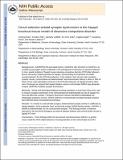| dc.contributor.author | Wan, Yehong | |
| dc.contributor.author | Ade, Kristen K. | |
| dc.contributor.author | Caffall, Zachary | |
| dc.contributor.author | Ilcim Ozlu, M. | |
| dc.contributor.author | Eroglu, Cagla | |
| dc.contributor.author | Feng, Guoping | |
| dc.contributor.author | Calakos, Nicole | |
| dc.date.accessioned | 2017-11-22T14:59:58Z | |
| dc.date.available | 2017-11-22T14:59:58Z | |
| dc.date.issued | 2013-02 | |
| dc.date.submitted | 2012-12 | |
| dc.identifier.issn | 0006-3223 | |
| dc.identifier.uri | http://hdl.handle.net/1721.1/112272 | |
| dc.description.abstract | Background: Synapse-associated protein 90/postsynaptic density protein 95-associated protein 3 (SAPAP3) is an excitatory postsynaptic protein implicated in the pathogenesis of obsessive-compulsive behaviors. In mice, genetic deletion of Sapap3 causes obsessive-compulsive disorder (OCD)-like behaviors that are rescued by striatal expression of Sapap3, demonstrating the importance of striatal neurotransmission for the OCD-like behaviors. In the striatum, there are two main excitatory synaptic circuits, corticostriatal and thalamostriatal. Neurotransmission defects in either or both of these circuits could potentially contribute to the OCD-like behaviors of Sapap3 knockout (KO) mice. Previously, we reported that Sapap3 deletion reduces corticostriatal alpha-amino-3-hydroxy-5-methyl-4-isoxazole-propionic acid-type glutamate receptor-mediated synaptic transmission. Methods: Whole-cell electrophysiological recording techniques in acute brain slices were used to measure synaptic transmission in the corticostriatal and thalamostriatal circuits of Sapap3 KO mice and littermate control animals. Transgenic fluorescent reporters identified striatopallidal and striatonigral projection neurons. SAPAP isoforms at corticostriatal and thalamostriatal synapses were detected using immunostaining techniques. Results: I n contrast to corticostriatal synapses, thalamostriatal synaptic activity is unaffected by Sapap3 deletion. At the molecular level, we find that another SAPAP family member, SAPAP4, is present at thalamostriatal, but not corticostriatal, synapses. This finding provides a molecular rationale for the functional divergence we observe between thalamic and cortical striatal circuits in Sapap3 KO mice. Conclusions: These findings define the circuit-level neurotransmission defects in a genetic mouse model for OCD-related behaviors, focusing attention on the corticostriatal circuit for mediating the behavioral abnormalities. Our results also provide the first evidence that SAPAP isoforms may be localized to synapses according to circuit-selective principles. | en_US |
| dc.description.sponsorship | National Institute of Mental Health (U.S.) (Grant MH081201) | en_US |
| dc.publisher | Elsevier | en_US |
| dc.relation.isversionof | http://dx.doi.org/10.1016/J.BIOPSYCH.2013.01.008 | en_US |
| dc.rights | Creative Commons Attribution-NonCommercial-NoDerivs License | en_US |
| dc.rights.uri | http://creativecommons.org/licenses/by-nc-nd/4.0/ | en_US |
| dc.source | PMC | en_US |
| dc.title | Circuit-Selective Striatal Synaptic Dysfunction in the Sapap3 Knockout Mouse Model of Obsessive-Compulsive Disorder | en_US |
| dc.type | Article | en_US |
| dc.identifier.citation | Wan, Yehong et al. “Circuit-Selective Striatal Synaptic Dysfunction in the Sapap3 Knockout Mouse Model of Obsessive-Compulsive Disorder.” Biological Psychiatry 75, 8 (April 2014): 623–630 © 2014 Society of Biological Psychiatry | en_US |
| dc.contributor.department | Massachusetts Institute of Technology. Department of Brain and Cognitive Sciences | en_US |
| dc.contributor.department | McGovern Institute for Brain Research at MIT | en_US |
| dc.contributor.mitauthor | Feng, Guoping | |
| dc.relation.journal | Biological Psychiatry | en_US |
| dc.eprint.version | Author's final manuscript | en_US |
| dc.type.uri | http://purl.org/eprint/type/JournalArticle | en_US |
| eprint.status | http://purl.org/eprint/status/PeerReviewed | en_US |
| dc.date.updated | 2017-11-06T13:23:07Z | |
| dspace.orderedauthors | Wan, Yehong; Ade, Kristen K.; Caffall, Zachary; Ilcim Ozlu, M.; Eroglu, Cagla; Feng, Guoping; Calakos, Nicole | en_US |
| dspace.embargo.terms | N | en_US |
| dc.identifier.orcid | https://orcid.org/0000-0002-8021-277X | |
| mit.license | PUBLISHER_CC | en_US |
